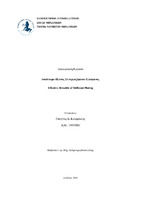| dc.contributor.advisor | Θεοδουλίδης, Αλέξανδρος | |
| dc.contributor.author | Κυπαρίσσης, Γεώργιος | |
| dc.date.accessioned | 2024-07-09T08:00:47Z | |
| dc.date.available | 2024-07-09T08:00:47Z | |
| dc.date.issued | 2024-06-28 | |
| dc.identifier.uri | https://polynoe.lib.uniwa.gr/xmlui/handle/11400/6972 | |
| dc.identifier.uri | http://dx.doi.org/10.26265/polynoe-6807 | |
| dc.description.abstract | Η παρούσα διπλωματική εργασία ασχολείται με την σημασία του ισοδύναμου πλάτους συνεργαζόμενου ελάσματος. Αρχικά, θα αναφερθούν οι Θεμελιώδεις Αρχές της Μηχανικής που χρειάζονται για την κατανόηση της συγκεκριμένης έννοιας, δηλαδή το φαινόμενο της κάμψης ενισχυμένων ελασμάτων και της υστέρησης λόγω διάτμησης. Επίσης, αντικείμενο της εργασίας είναι η ανασκόπηση και η συγκριτική αξιολόγηση των σχετικών απαιτήσεων των Κοινών Κατασκευαστικών Κανονισμών, των σημαντικότερων Νηογνωμόνων που αποτελούν μέλη του IACS και του πειραματικού τύπου που προκύπτει από την εργασία του Ι. Γ. Τίγκα και Α. Θεοδουλίδη. Επίσης, θα γίνει χρήση και του σχετικού διαγράμματος του Schade. Οι απαιτήσεις αυτές θα συγκριθούν με μία συστηματική αριθμητική διερεύνηση με την χρήση του προγράμματος Ansys, το οποίο βασίζεται στην Μέθοδο των Πεπερασμένων Στοιχείων. Πιο συγκεκριμένα, θα γίνει η συστηματική μελέτη ενός μοντέλου αποτελούμενο από ένα συνεργαζόμενο έλασμα και πέντε (5) διαμήκη ενισχυτικά. Σκοπός είναι να αλλάξουν κάποιες βασικές παράμετροι του προβλήματος (μήκος κατασκευής, πάχος ελάσματος, στηρίξεις, φορτία, είδος ενισχυτικών κ.λ.π) ώστε να γίνει αντιληπτός ο τρόπος μεταβολής του ισοδύναμου πλάτους για το κεντρικό ενισχυτικό της κατασκευής. Τα αποτελέσματα του προγράμματος θα συγκριθούν με τους αντίστοιχους κανονισμούς και το διάγραμμα του Schade, τα οποία θα μας οδηγήσουν στα κατάλληλα αποτελέσματα και συμπεράσματα. | el |
| dc.format.extent | 206 | el |
| dc.language.iso | el | el |
| dc.publisher | Πανεπιστήμιο Δυτικής Αττικής | el |
| dc.rights | Αναφορά Δημιουργού - Μη Εμπορική Χρήση - Παρόμοια Διανομή 4.0 Διεθνές | * |
| dc.rights | Attribution-NonCommercial-NoDerivatives 4.0 Διεθνές | * |
| dc.rights.uri | http://creativecommons.org/licenses/by-nc-nd/4.0/ | * |
| dc.subject | Ισοδύναμο πλάτος | el |
| dc.subject | Συνεργαζόμενο - ενισχυμένο έλασμα | el |
| dc.subject | Κεντρικό ενισχυτικό | el |
| dc.subject | Κανονισμοί νηογνωμόνων | el |
| dc.subject | Κοινοί κατασκευαστικοί κανονισμοί | el |
| dc.subject | Διάγραμμα Schade | el |
| dc.subject | Μέθοδος πεπερασμένων στοιχείων | el |
| dc.subject | Πρόγραμμα Ansys | el |
| dc.title | Ισοδύναμο πλάτος συνεργαζόμενου ελάσματος | el |
| dc.title.alternative | Effective breadth of stiffened plating | el |
| dc.type | Διπλωματική εργασία | el |
| dc.contributor.committee | Τίγκας, Ιωάννης | |
| dc.contributor.committee | Mazarakos, Thomas | |
| dc.contributor.faculty | Σχολή Μηχανικών | el |
| dc.contributor.department | Τμήμα Ναυπηγών Μηχανικών | el |
| dc.description.abstracttranslated | This diploma thesis deals with the importance of the effective breadth of stiffened plating. First, the Fundamental Principles of Mechanics needed to understand the specific concept, namely the phenomenon of bending of stiffened plates and shear lag, will be mentioned. Also, the subject of the work is the review and comparative evaluation of the relevant requirements of the Common Structural Rules, the most important Classification Societies who are members of IACS and the experimental formula resulting from the work of I. G. Tigkas and A. Theodoulides. Also, the relevant Schade's diagram will be used. These requirements will be compared with a systematic numerical investigation using the Ansys program, which is based on the Finite Element Method. More specifically, the systematic study of a model consisting of a cooperating plate and five (5) longitudinal stiffeners will be done. The purpose is to change some basic parameters of the problem (length, plate thickness, supports, loads, type of stiffeners, etc.) in order to understand the way of changing the effective breadth for the central stiffener of the structure. The results of the program will be compared with the respective regulations and Schade's diagram, which will lead us to the appropriate results and conclusions. | el |


